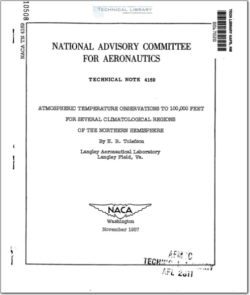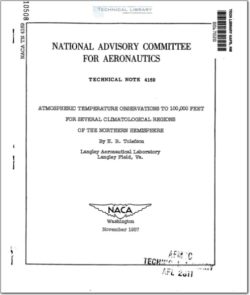NACA-TN-4169

- Version
- 188 Downloads
- 1.48 MB File Size
- 1 File Count
- December 4, 2015 Create Date
- December 4, 2015 Last Updated
National Advisory Committee for Aeronautics, Technical Notes - Atmospheric Temperature Observations to 100,000ft for Several Climatological Regions of the Northern Hemisphere

Radiosonde measurements of upper-air temperatures taken over a
5-year period at nine stations in the northern hemisphere are summarized
in order to provide information on the temperatures likely to be encoun-
tered during airplane and missile operations up to 100,000 feet. The
results are in general agreement with those from previous investigations
of upper-air temperatures and indicate that the mean temperatures from
the tropopause to.lO0,000 feet tend to increase fairly regularly and
rapidly for southern locations, whereas a smaller increase occurs for
more northerly locations. The scatter in the temperatures about the
mean generally decreased with increasing altitude from the tropopause
to 100,000 feet. Little, if any, effect of location upon the tempera-
ture was apparent for altitudes above about 90,000 feet.
Data on the atmospheric temperatures at different altitudes have a
number of applications during both the design phases and the actual
operations of high-speed airplanes and missiles. MEasurements of the
upper—air temperatures were summarized some time ago by the United States
Weather Bureau in reference 1 in order to provide information on the
frequency with which given temperatures might be expected at different
altitudes and locations. These data covered radiosonde observations
made over a 5-year period from_locations within the continental United
States and in adjoining areas and, because of limitations of the sounding
equipment, were restricted to altitudes of about 50,000 feet.
With the more recent design of airplanes and missiles having much
greater altitude and range capabilities, temperature data are now needed
for higher altitudes and for other areas throughout the world. A sum-
mary of radiosonde temperature measurements was accordingly undertaken
by the National Advisory Committee for Aeronautics to extend the results
in reference 1 to altitudes of about 100,000 feet and to several loca—
tions in the northern hemisphere. Although both the altitude and the
area coverage of the results represented_by this study are still limited,
an effort was made through choice of_station locations to obtain tempera-
ture data which could be considered representative of some of the wider
climatological or geographical areas of the northern hemisphere.
| File | Action |
|---|---|
| naca-tn-4169.pdf | Download |

Comment On This Post